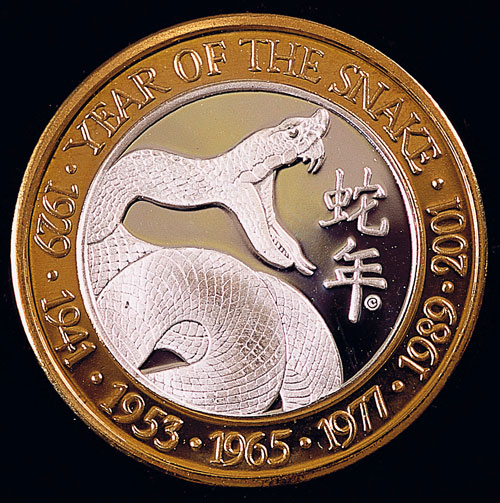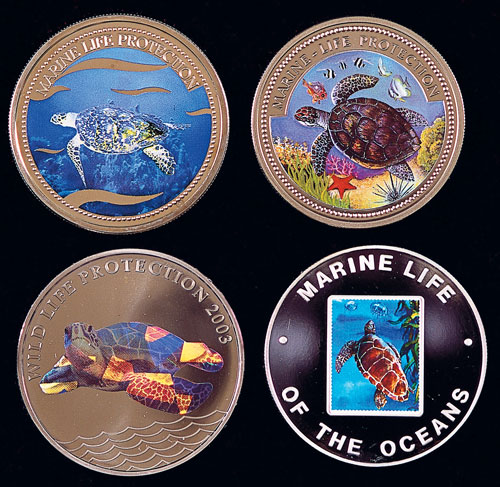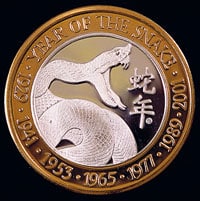Supplement to the January 2009 REPTILES magazine article "Herps Craved & Engraved."
Collecting herp-themed coins can be fun and profitable if you make wise choices. Two methods are used to grade coins. The standard scale uses adjectives to describe quality. “Proof” is the highest, most desirable and valuable grade. The remaining grades in descending order are somewhat subjective.

Bill Fogel
This 100-pace casino silver strike showcases a viper.
Word Grades
Grade: Proof
Circulation: Rare. Often minted especially for coin collectors.
Condition: A mirrorlike surface with no visible wear.

Bill Fogel
Sea turtles figure prominently on these foreign silver proof coins.
Grade: Almost uncirculated
Circulation: Moderate.
Condition: Traces of visible wear to coin’s highest points.
Grade: Extra fine
Circulation: Circulated.
Condition: Light visible wear.
Grade: Very fine
Circulation: Circulated.
Condition: Light to moderate visible wear with all features sharp.
Grade: Fine
Circulation: Circulated.
Condition: Even, moderate to heavy wear with entire design present and bold.
Grade: Very good
Circulation: Circulated.
Condition: Well-worn with a clear design that’s flat and lacking details.
Grade: Good
Circulation: Circulated.
Condition: Heavy wear with a viable design that’s faint in spots.
Number Grades
More recently, a coin-grading system with numbers has been implemented. This system incorporates a 70-point scale. A perfect coin is 70, an uncirculated condition is 60 and so on. Unless exceptionally rare, any coin under a grade three is not collectible.
Investment Protection
Once you know what your coins are worth, you can protect and display them a number of ways. Popular choices are round plastic or acrylic holders just barely larger than the coin, or square pockets with a sized, round “window.”
The most common display method incorporates 2-inch square cardboard holders. Available with circular cutouts of various sizes, these holders coincide primarily with U.S. coin dimensions and are covered by a Mylar window. With the coin centered in the window, the cardboard holder is folded and either stapled or sealed with adhesive. Then the holders can then be inserted into 20-pocket, clear-plastic pages and stored in standard three-ring binders or albums.
A 2½-inch square holder similar to the 2-inch variety is available for oversize coins, tokens, etc. Twelve-pocket binder pages accommodate these larger holders.
Coin holders and pages are available at coin shops and through Internet coin-supply dealers.
Want to read the full story? Pick up the January 2009 issue of REPTILES, or subscribe to get 12 months of articles just like this.


